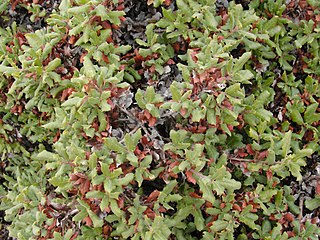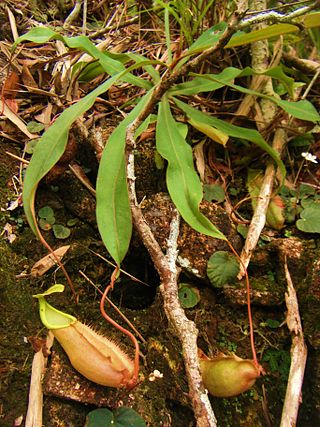
Quercus montana, the chestnut oak, is a species of oak in the white oak group, Quercus sect. Quercus. It is native to the eastern United States, where it is one of the most important ridgetop trees from southern Maine southwest to central Mississippi, with an outlying northwestern population in southern Michigan. It is also sometimes called rock oak because of its presence in montane and other rocky habitats.

Quercus robur, the pedunculate oak, is a species of flowering plant in the beech and oak family, Fagaceae. It is a large tree, native to most of Europe and western Asia, and is widely cultivated in other temperate regions. It grows on soils of near neutral acidity in the lowlands and is notable for its value to natural ecosystems, supporting a very wide diversity of herbivorous insects and other pests, predators and pathogens.

Quercus georgiana, the Georgia oak or Stone Mountain oak, is a rare deciduous red oak, native to the southeastern United States.

Pachypodium ambongense is a species of plant in the family Apocynaceae. It was first published as a species of the genus Pachypodium in 1924 by the botanist Henri Louis Poisson.

Quercus shumardii, the Shumard oak, spotted oak, Schneck oak, Shumard red oak, or swamp red oak, is one of the largest of the oak species in the red oak group. It is closely related to Quercus buckleyi, Quercus texana, and Quercus gravesii.

Nepenthes rigidifolia is a critically endangered tropical pitcher plant endemic to Sumatra, where it grows at elevations of 1000–1600 m above sea level.

Quercus durata, commonly known as leather oak, is a species of oak endemic to California, common in the Coast Ranges and the foothills of the Sierra Nevada. The common name "leather oak" is derived from the leathery texture on the lop of its leaves. Taxonomically it is placed in the white oak group.

Gossypium arboreum, commonly called tree cotton, is a species of cotton native to India, Pakistan and Bangladesh and other tropical and subtropical regions of the Old World. There is evidence of its cultivation as long ago as the Harappan civilization of the Indus Valley for the production of cotton textiles. The shrub was included in Linnaeus's Species Plantarum published in 1753. The holotype was also supplied by him, which is now in the Linnean Herbarium in the Swedish Museum of Natural History.

Cephalotaxus fortunei, commonly called the Chinese plum-yew, Fortune's yew plum, simply plum yew, Chinese cowtail pine or in Chinese as san jian shan, is a coniferous shrub or small tree in the family Taxaceae. It is native to northern Burma and China, but is sometimes grown in western gardens where it has been in cultivation since 1848.

Mangifera zeylanica or "Sri Lanka wild mango" is a wild species of mango tree endemic to Sri Lanka. This stately tree is the tallest member of the mango genus, Mangifera, and one of the two tallest trees in the family Anacardiaceae. The mango fruits are edible and have an excellent taste. It is called "aetamba" (ඇටඹ) or "wal amba" in Sinhala and “kaddu-ma” in Tamil. The well-known British botanist and explorer Joseph Dalton Hooker first described the tree in 1876.

Commelina diffusa, sometimes known as the climbing dayflower or spreading dayflower, is a pantropical herbaceous plant in the dayflower family. It has been introduced to the southeastern United States where it is most common in wet disturbed soils. There are two recognised varieties, one being the type and the other being C. diffusa var. gigas, which is native to Asia and has been introduced to Florida. It flowers from spring to fall and is most common in disturbed situations, moist places and forests. In China the plant is used medicinally as a febrifuge and a diuretic. A blue dye is also extracted from the flower for paints. In the Hawaiian Islands, it is known as "honohono grass", although it is technically not a grass. "Honohono" refers to the alternating structure of the leaves. At least one publication lists it as an edible plant in New Guinea.

Cinnamomum iners is a tree species in the family Lauraceae described by Reinwardt and Blume. No subspecies are listed in the Catalogue of Life. It occurs naturally in Myanmar, Thailand, Laos, Cambodia, Vietnam, Malaysia, Indonesia, Brunei, Singapore, the Philippines and southern China.

Nepenthes andamana is a tropical pitcher plant endemic to Phang Nga Province, Thailand, where it grows near sea level in coastal savannah and grassland. It is thought to be most closely related to N. suratensis.

Nepenthes chang is a tropical pitcher plant endemic to the Banthad Mountains of central Thailand, where it grows at elevations of 300–600 m above sea level. It is thought to be most closely related to N. kampotiana.
Quercus langbianensis is an uncommon oak tree species in the family Fagaceae. It is placed in subgenus Cerris, section Cyclobalanopsis, the ring-cupped oaks. These differ from other Quercus groups in that they have acorns with distinctive cups: usually with substantial rings, made-up of scales that have grown together. This species can be found in sub-tropical and tropical seasonal forests of Cambodia, China and Vietnam.

Prunus himalayana, called jyokun shin in Tibetan and 喜马拉雅臭樱 in Chinese, is a species of Prunus native to Nepal, Bhutan, Sikkim and Tibet. It prefers to grow 2,800 to 4,200 m above sea level in the Himalayas. As Maddenia himalaica it was the type species for the now unrecognized genus Maddenia.
Colona thorelii is a species small tree, in the family Malvaceae and now placed in the subfamily Grewioideae; it is named after the French botanist Clovis Thorel. No subspecies are listed in the Catalogue of Life.
Salix chienii is a large shrub or small tree in the willow genus Salix with initially light green and tomentose hairy and later reddish brown and balding branches. The leaf blades have lengths of 2 to 3.5 sometimes 5.5 centimeters. The natural range of the species is in China.

Quercus opaca, commonly called the colonial oak, is a species of evergreen shrub in the genus Quercus. It is found throughout northeastern Mexico.
Quercus manzanillana is a shrub in the genus Quercus indigenous to Mexico. It was described in 1924 by William Trelease. It is found in the Mexican state of Puebla.

















